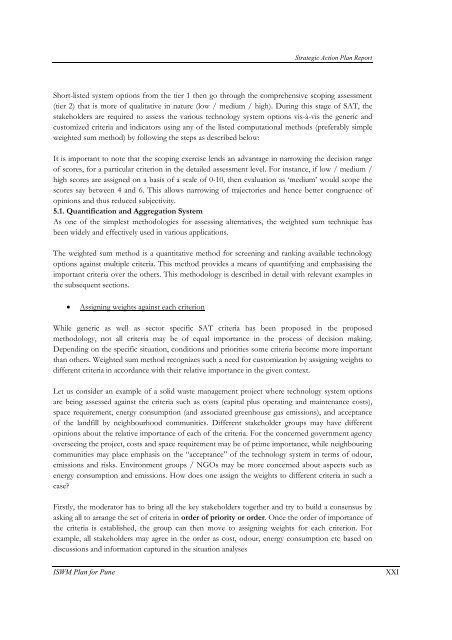Strategic Action Plan - International Environmental Technology Centre
Strategic Action Plan - International Environmental Technology Centre
Strategic Action Plan - International Environmental Technology Centre
You also want an ePaper? Increase the reach of your titles
YUMPU automatically turns print PDFs into web optimized ePapers that Google loves.
<strong>Strategic</strong> <strong>Action</strong> <strong>Plan</strong> Report<br />
Short-listed system options from the tier 1 then go through the comprehensive scoping assessment<br />
(tier 2) that is more of qualitative in nature (low / medium / high). During this stage of SAT, the<br />
stakeholders are required to assess the various technology system options vis-à-vis the generic and<br />
customized criteria and indicators using any of the listed computational methods (preferably simple<br />
weighted sum method) by following the steps as described below:<br />
It is important to note that the scoping exercise lends an advantage in narrowing the decision range<br />
of scores, for a particular criterion in the detailed assessment level. For instance, if low / medium /<br />
high scores are assigned on a basis of a scale of 0-10, then evaluation as ‘medium’ would scope the<br />
scores say between 4 and 6. This allows narrowing of trajectories and hence better congruence of<br />
opinions and thus reduced subjectivity.<br />
5.1. Quantification and Aggregation System<br />
As one of the simplest methodologies for assessing alternatives, the weighted sum technique has<br />
been widely and effectively used in various applications.<br />
The weighted sum method is a quantitative method for screening and ranking available technology<br />
options against multiple criteria. This method provides a means of quantifying and emphasising the<br />
important criteria over the others. This methodology is described in detail with relevant examples in<br />
the subsequent sections.<br />
• Assigning weights against each criterion<br />
While generic as well as sector specific SAT criteria has been proposed in the proposed<br />
methodology, not all criteria may be of equal importance in the process of decision making.<br />
Depending on the specific situation, conditions and priorities some criteria become more important<br />
than others. Weighted sum method recognizes such a need for customization by assigning weights to<br />
different criteria in accordance with their relative importance in the given context.<br />
Let us consider an example of a solid waste management project where technology system options<br />
are being assessed against the criteria such as costs (capital plus operating and maintenance costs),<br />
space requirement, energy consumption (and associated greenhouse gas emissions), and acceptance<br />
of the landfill by neighbourhood communities. Different stakeholder groups may have different<br />
opinions about the relative importance of each of the criteria. For the concerned government agency<br />
overseeing the project, costs and space requirement may be of prime importance, while neighbouring<br />
communities may place emphasis on the “acceptance” of the technology system in terms of odour,<br />
emissions and risks. Environment groups / NGOs may be more concerned about aspects such as<br />
energy consumption and emissions. How does one assign the weights to different criteria in such a<br />
case?<br />
Firstly, the moderator has to bring all the key stakeholders together and try to build a consensus by<br />
asking all to arrange the set of criteria in order of priority or order. Once the order of importance of<br />
the criteria is established, the group can then move to assigning weights for each criterion. For<br />
example, all stakeholders may agree in the order as cost, odour, energy consumption etc based on<br />
discussions and information captured in the situation analyses<br />
ISWM <strong>Plan</strong> for Pune<br />
XXI
















